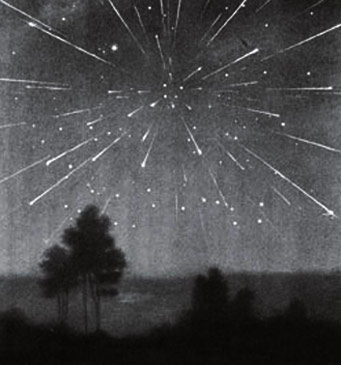| Update: Despite high hopes, visual reports of meteors were scant. By nightfall in North America the radar outburst was basically over. Even in Europe, where darkness came several hours earlier, few were seen by eye. |

The Draconid meteor storm of October 9, 1933, was seen all across Europe. Formerly called the Giacobinids, the shower appears to radiate from a point near in the head of Draco. This painting appeared in the 1959 edition of the Larousse Encyclopedia of Astronomy.
Lucien Rudeaux
Draconid outbursts tend to be very short and intense, lasting just a few hours. If it's dark where you are, go look now! If it's still day, look as soon as darkness falls. Unlike most meteor showers, the Draconids are most active in early evening; that's when the radiant, near the head of Draco, is highest.
Please report what you see in the comments section below.
The Draconids (also called the Giacobinids, for the periodic comet that shed them, 21P/Giacobini-Zinner) produced great meteor storms in 1933 and 1946, and lesser outbursts in 1988, 2005, and 2011. But in most years the shower is much sparser or nonexistent.
 1
1
Comments
Toby Tomlins
October 8, 2012 at 4:37 pm
I've seen 1 very small and very quick, what I suspect to be a meteorite. I saw it as I was facing North to North-West of England. I'm pretty certain of this due to the sound radar over Canada picking it up, then leading to my sighing.
Toby Tomlins.
You must be logged in to post a comment.
You must be logged in to post a comment.